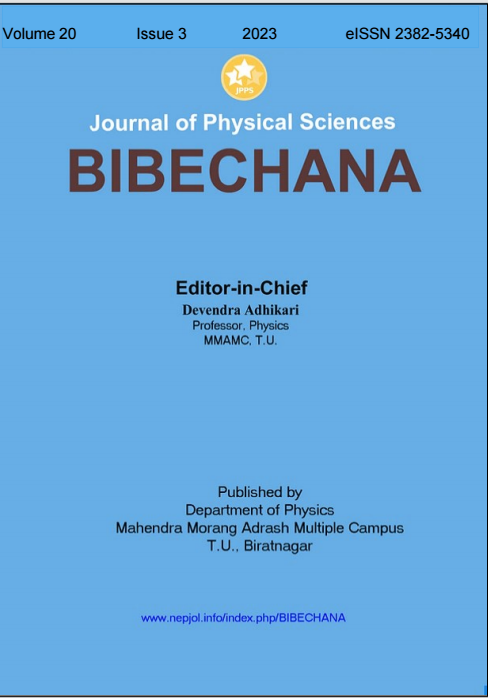Effects of calcination and sintering processes on structural profile parameters of modified BNKT-based ferroelectric ceramics
DOI:
https://doi.org/10.3126/bibechana.v20i3.58594Keywords:
Ferroelectrics, Micro-strain, Crystallites size, Williamson -Hall plotAbstract
We have carried out a detailed study of synthesis and variations of structural profile parameters: lattice constants, unit cell volume, densities, porosity, crystallite size, dislocation density and micro-strain of BMZ modified BNKT (1-x) Bi0.5(Na0.70K0.30)0.5TiO3-xBiMg0.5Zr0.5O3 for x=0, 0.03, 0.06, 0.09 and 0.12 using x-ray diffraction. The conventional solid-state reaction method was used to synthesize BNKT samples. The BNKT powders were calcined at an optimized temperature of 850 °C for 2 hours. Keeping the calcination temperature fixed, optimized sintering temperature and time were also determined to be 11400C for 2 hours, based on the sharpness of the peaks and densification. The nature of the XRD patterns is qualitatively similar to that observed for calcined powders, however, the reflections are sharper in sintered samples presumably due to an increase in particle size. The XRD profile reveals an almost pure perovskite structure with cubic symmetries for all samples in both calcined powders as well as sintered samples. The crystallite size, dislocation densities, and micro-strain were determined by using William-Hall plots as well as Scherrer formula. It is observed that the maximum bulk density was found to be 5.88 gm/cm3 for x=0.03 which is 96.39 % of the theoretical density. The crystallite size varies from 19.84 - 44.15 nm with compositions for calcined powders and from 57.01- 62.69 nm for sintered samples. The very low value of crystallite sizes of calcined powder indicates that the particle size is comparably very low to that of sintered samples. The dislocation densities and micro-strain for calcined and sintered powders were observed in the range (5.1- 25.4)´10-4nm-2, and (2.54 - 3.1) ´10-4 nm-2 and (1.3 -4.8) ´10-3 and (8.93 - 9.90) ´10-4 respectively which are determined using William-Hall plot method. These results are also confirmed by the results obtained from the Scherrer method. Both results show improved profile parameters in sintered compositions than in calcination. This verifies that sintered BMZ-doped BNKT powders are promising candidates for many dielectric-based energy storage applications.
Downloads
Downloads
Published
How to Cite
Issue
Section
License
Copyright (c) 2023 Ram Prasad Aryal, Binod Kumar Bhattarai, Bhadra Prasad Pokhrel

This work is licensed under a Creative Commons Attribution-NonCommercial 4.0 International License.
This license enables reusers to distribute, remix, adapt, and build upon the material in any medium or format for noncommercial purposes only, and only so long as attribution is given to the creator.




